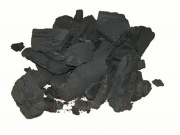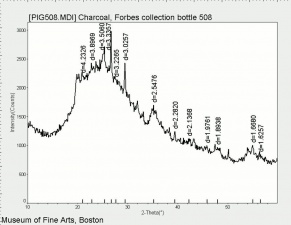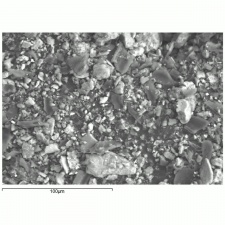Difference between revisions of "Charcoal"
| Line 3: | Line 3: | ||
A black, porous carbonaceous material. Charcoal is the [[carbon]] containing residue from burned wood (e.g., [[willow]], [[maple]], [[beech]], [[linden]] or [[plum (tree)|plum]]) or other organic containing materials such as bone, plants or animals. Charcoal contains 80 to 98% carbon with some ash and moisture. Charcoal has been used since ancient times as a drawing material and pigment (see [[charcoal black]]). Charcoal is also sold commercially as a fuel, abrasive, sorbent, filter media, and decolorizer. | A black, porous carbonaceous material. Charcoal is the [[carbon]] containing residue from burned wood (e.g., [[willow]], [[maple]], [[beech]], [[linden]] or [[plum (tree)|plum]]) or other organic containing materials such as bone, plants or animals. Charcoal contains 80 to 98% carbon with some ash and moisture. Charcoal has been used since ancient times as a drawing material and pigment (see [[charcoal black]]). Charcoal is also sold commercially as a fuel, abrasive, sorbent, filter media, and decolorizer. | ||
| − | + | [[File:image7_charcoal.jpg|thumb|Charcoal]] | |
See also [[activated carbon]], and [[charcoal crayon]]. | See also [[activated carbon]], and [[charcoal crayon]]. | ||
| − | |||
| − | |||
== Synonyms and Related Terms == | == Synonyms and Related Terms == | ||
| Line 15: | Line 13: | ||
== Risks == | == Risks == | ||
| − | Fire risk. May ignite spontaneously in air. | + | * Fire risk. May ignite spontaneously in air. |
== Physical and Chemical Properties == | == Physical and Chemical Properties == | ||
| − | + | * Tiny wood splinters may be visible microscopically. | |
| − | + | * Density = oak=0.57; pine=0.28-0.44 | |
| − | |||
| − | |||
| − | |||
| − | |||
| − | |||
== Additional Images == | == Additional Images == | ||
| − | |||
<gallery> | <gallery> | ||
File:natvscomp charcoal.jpg|Charcoal | File:natvscomp charcoal.jpg|Charcoal | ||
| Line 36: | Line 28: | ||
== Resources and Citations == | == Resources and Citations == | ||
| − | |||
* G.S.Brady, ''Materials Handbook'', McGraw-Hill Book Co., New York, 1971 Comment: p. 182 | * G.S.Brady, ''Materials Handbook'', McGraw-Hill Book Co., New York, 1971 Comment: p. 182 | ||
| − | |||
* Ralph Mayer, ''A Dictionary of Art Terms and Techniques'', Harper and Row Publishers, New York, 1969 (also 1945 printing) | * Ralph Mayer, ''A Dictionary of Art Terms and Techniques'', Harper and Row Publishers, New York, 1969 (also 1945 printing) | ||
| − | |||
* R.D. Harley, ''Artists' Pigments c. 1600-1835'', Butterworth Scientific, London, 1982 | * R.D. Harley, ''Artists' Pigments c. 1600-1835'', Butterworth Scientific, London, 1982 | ||
| − | |||
* Wikipedia: http://en.wikipedia.org/wiki/Charcoal (Accessed Sept. 2 2005) | * Wikipedia: http://en.wikipedia.org/wiki/Charcoal (Accessed Sept. 2 2005) | ||
| − | |||
* ''CRC Handbook of Chemistry and Physics'', Robert Weast (ed.), CRC Press, Boca Raton, Florida, v. 61, 1980 Comment: density for oak=0.57; pine=0.28-0.44 | * ''CRC Handbook of Chemistry and Physics'', Robert Weast (ed.), CRC Press, Boca Raton, Florida, v. 61, 1980 Comment: density for oak=0.57; pine=0.28-0.44 | ||
| − | |||
* Richard S. Lewis, ''Hawley's Condensed Chemical Dictionary'', Van Nostrand Reinhold, New York, 10th ed., 1993 | * Richard S. Lewis, ''Hawley's Condensed Chemical Dictionary'', Van Nostrand Reinhold, New York, 10th ed., 1993 | ||
| − | |||
* Random House, ''Webster's Encyclopedic Unabridged Dictionary of the English Language'', Grammercy Book, New York, 1997 | * Random House, ''Webster's Encyclopedic Unabridged Dictionary of the English Language'', Grammercy Book, New York, 1997 | ||
| − | |||
* ''The American Heritage Dictionary'' or ''Encarta'', via Microsoft Bookshelf 98, Microsoft Corp., 1998 | * ''The American Heritage Dictionary'' or ''Encarta'', via Microsoft Bookshelf 98, Microsoft Corp., 1998 | ||
| − | |||
[[Category:Materials database]] | [[Category:Materials database]] | ||
Revision as of 11:25, 13 March 2025
Description
A black, porous carbonaceous material. Charcoal is the Carbon containing residue from burned wood (e.g., Willow, Maple, Beech, Linden or plum) or other organic containing materials such as bone, plants or animals. Charcoal contains 80 to 98% carbon with some ash and moisture. Charcoal has been used since ancient times as a drawing material and pigment (see Charcoal black). Charcoal is also sold commercially as a fuel, abrasive, sorbent, filter media, and decolorizer.
See also Activated carbon, and Charcoal crayon.
Synonyms and Related Terms
trækul (Dan.); negro carbón (Esp.); carbón vegetal (Esp.); Holzkohle (Deut.); charbon de bois (Fr.); karboyno (Gr.); carbonella (It.); carbone (It.); carbo ligni (Lat.); houtskool zwart (Ned.); carvão vegetal (Port.)
Risks
- Fire risk. May ignite spontaneously in air.
Physical and Chemical Properties
- Tiny wood splinters may be visible microscopically.
- Density = oak=0.57; pine=0.28-0.44
Additional Images
Resources and Citations
- G.S.Brady, Materials Handbook, McGraw-Hill Book Co., New York, 1971 Comment: p. 182
- Ralph Mayer, A Dictionary of Art Terms and Techniques, Harper and Row Publishers, New York, 1969 (also 1945 printing)
- R.D. Harley, Artists' Pigments c. 1600-1835, Butterworth Scientific, London, 1982
- Wikipedia: http://en.wikipedia.org/wiki/Charcoal (Accessed Sept. 2 2005)
- CRC Handbook of Chemistry and Physics, Robert Weast (ed.), CRC Press, Boca Raton, Florida, v. 61, 1980 Comment: density for oak=0.57; pine=0.28-0.44
- Richard S. Lewis, Hawley's Condensed Chemical Dictionary, Van Nostrand Reinhold, New York, 10th ed., 1993
- Random House, Webster's Encyclopedic Unabridged Dictionary of the English Language, Grammercy Book, New York, 1997
- The American Heritage Dictionary or Encarta, via Microsoft Bookshelf 98, Microsoft Corp., 1998








